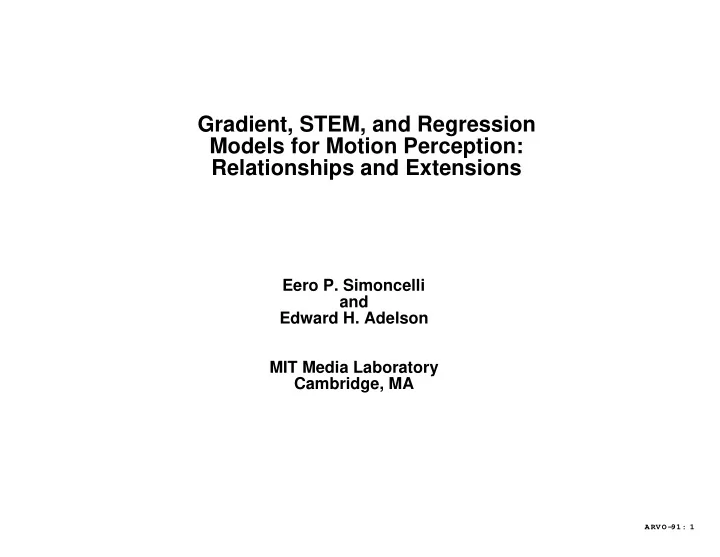

Gradient, STEM, and Regression Models for Motion Perception: Relationships and Extensions Eero P. Simoncelli and Edward H. Adelson MIT Media Laboratory Cambridge, MA ARVO- 91: 1
Outline • Three seemingly unrelated standard techniques for estimating motion. • Similarity of these techniques. • Failure of these techniques to detect or represent multiple motions. • A simple extension that detects multiple motions. ARVO- 91: 2
Spatio-temporal Energy Models t x • Concept: motion is orientation in "space-time". f r , f l , f s • Measurements: convolution with tuned filters. R = f r * I, L = f l * I, S = f s * I • Computation of opponent "motion energy" from quadratic combinations of filter outputs: 2 2 E = R - L ARVO- 91: 3
Gradient techniques x • Concept: intensity conservation. Image approximated by a translating ramp. I x v + I t = 0 • Measurements: partial derivatives. I x = dI/dx, I t = dI/dt • Least squares velocity: computed by blurring quadratic combinations of measurements. v = Σ I x I t / Σ I x 2 ARVO- 91: 4
Spatio-temporal Frequency Regression ω t ω x • Concept: Fourier transform of a translating image lies on a line. • Measurements: use Gabor-like filters to estimate spectral content. • Velocity: slope of best-fitting line. ARVO- 91: 5
STEM: common form • Choose filters that are directional derivatives of prefilter, g: ω t f r = g x + g t f l = g x - g t ω x f s = g x • Now can compute v from opponent energy: 2 2 R - L = (g x * I) (g t * I) = I x I t v = Σ (R - L ) / Σ S 2 2 2 ARVO- 91: 6
Gradient: common form • Derivatives are computed by convolving with two filters: I x = g x * I, I t = g t * I where g is a (lowpass) interpolation prefilter. • As with STEM, R , S , and L may be computed from space-time derivatives: 2 2 R - L = I x I t v = Σ (R - L ) / Σ S 2 2 2 ARVO- 91: 7
Regression: common form • Compute linear regression on the prefiltered image spectrum: ~ E(v) = Σ (v ω x + ω t ) | I | 2 2 ~ ~ 2 = Σ | v ω x I + ω t I | • Use Parseval's Theorem to switch to space-time domain: 2 E(v) = Σ (v I x + I t ) 2 v min = Σ I x I t / Σ I x • As with gradient solution, can write as opponent energy computation: v = Σ (R - L ) / Σ S 2 2 2 ARVO- 91: 8
All Three Techniques . . . • ... are fundamentally the same when considered as linear least-squares velocity estimators with suitable choice of filters. • ... are based on local linear measurements (convolutions) followed by non-linear (quadratic) velocity computation. • ... can be extended to compute physiologically plausible distributed velocity representations (ARVO-90). • ... are designed to compute single motions: Information about multiple motions is discarded at the measurement stage! ARVO- 91: 9
Multiple Motions • Three Example Cases: x t - Occluding contours. - Non-translational flow: (e.g. expansion, contraction, rotation). - Transparency. • Comments: - Occur frequently in natural scenes. - Provide important information about depth ordering, approach/withdrawal, material properties, etc. ARVO- 91: 10
Detecting Multiple Motions • One additional linear measurement: ω t ω x A = f total * I • To determine if there are multiple motions, compare total energy to derivative energy: 2 E total = A 2 2 2 2 E derivative = I x + I t = R + L ARVO- 91: 11
Results • One-dimensional test image: [Image Here] • Multiple motion detector output: [Image Here] ARVO- 91: 12
Conclusions • Gradient, Spatio-temporal Energy, and Regression models for early motion processing are very similar (identical with proper choice of parameters). • All three of these techniques (in their common forms) cannot detect or represent multiple motions. • There are simple extensions to these techniques which allow detection of multiple motions. ARVO- 91: 13
Recommend
More recommend